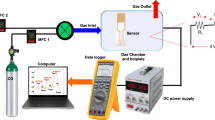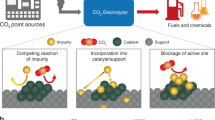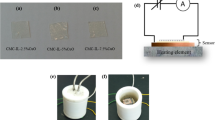Abstract
The electrical properties of tin(iv) oxide render it an excellent material for the detection of very low levels of carbon monoxide, and several devices based on sintered pellets of SnO2 are commercially available1,2. Investigations of the operation of such sensors have generally been restricted to studies of the electrical behaviour of the oxide and little attention has been paid to the relationship between the surface adsorption phenomena and electrical changes in the bulk oxide. These studies3 demonstrated the consistency of a model in which conductance is effectively controlled by the population of negatively charged oxygen adsorbates. The chemical reactions occurring at the oxide surface, although unsubstantiated, have been assumed to involve CO adsorption, desorption of CO2 (which produces an increase in conductance) and replenishment of the resulting surface oxygen vacancy by adsorption of molecular oxygen4. Here we describe experiments in which the nature of the surface species adsorbed into tin(iv) oxide from atmospheres containing low levels of carbon monoxide is monitored using transmission infrared spectroscopy while simultaneously measuring the electrical changes produced in the bulk oxide. The data demonstrate the effect of heat treatment on the formation of adsorbate species and the mutual interdependence of adsorbate species and bulk oxide electrical conductance. This relationship is important both for sensor operation and heterogeneous catalysis.
This is a preview of subscription content, access via your institution
Access options
Subscribe to this journal
Receive 51 print issues and online access
$199.00 per year
only $3.90 per issue
Buy this article
- Purchase on Springer Link
- Instant access to full article PDF
Prices may be subject to local taxes which are calculated during checkout
Similar content being viewed by others
References
Watson, J. & Yates, R. A. Electronic Engng, 47–57 (1985).
Karpel, S. Tin and its Uses, No. 149, 1–3 (1986).
McAleer, J. F., Moseley, P. T., Norris, J. O. W. & Williams, D. E. JCS, Faraday I Trans. 83, 1323–1346 (1987).
Windischmann, H. & Mark, P. J. Electrochem. Soc., 126, 627–633 (1979).
Joly, J. P., Gonzalez-Cruz, L. & Arnaud, Y., Bull. Soc. chim. Fr. 11–17 (1986).
Chang, S.-C. J. Vac. Sci. Technol., 17, 366–369 (1980).
Harrison, P. G. & Guest, A. JCS, Faraday I Trans. 83, 3388–3397 (1987).
Author information
Authors and Affiliations
Rights and permissions
About this article
Cite this article
Harrison, P., Willett, M. The mechanism of operation of tin(iv) oxide carbon monoxide sensors. Nature 332, 337–339 (1988). https://doi.org/10.1038/332337a0
Received:
Accepted:
Issue Date:
DOI: https://doi.org/10.1038/332337a0
This article is cited by
-
Exclusive detection of volatile aromatic hydrocarbons using bilayer oxide chemiresistors with catalytic overlayers
Nature Communications (2023)
-
Defect driven enhanced ferromagnetism in Sb-modified SnO2 nanoparticles
Journal of Materials Science: Materials in Electronics (2023)
-
Mobility–stability trade-off in oxide thin-film transistors
Nature Electronics (2021)
-
The Synthesis of Metallic β-Sn Nanostructures for Use as a Novel Pt Catalyst Support and Evaluation of Their Activity Toward Methanol Electrooxidation
Electrocatalysis (2015)
-
Ferromagnetic spin-order in SnO2 nanoparticles with nonmagnetic Li doping
Journal of Materials Science: Materials in Electronics (2015)
Comments
By submitting a comment you agree to abide by our Terms and Community Guidelines. If you find something abusive or that does not comply with our terms or guidelines please flag it as inappropriate.



